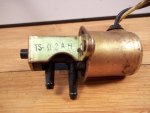I am not sure exactly what year model my force engine is, i found the rough year made by the carby number. Because i can't find the ID plate on the engine body.
Anyway, my force is little bit hard to start. And once I got it started and let it idle for a while it would stall, or it will stall if i gently put into gear.
I have tested. So i assume either my rectifier or my charging coil went. I have seen a YouTube video describing about similar issue i am having. And he has to replace the rectifier to get the problem solved. Here is the link
https://www.youtube.com/watch?v=Q-VnMs6DiYs
And i just have my fuel line and fuel pump gasket replaced with no improvement.
But the question I have is, how would rectifier effect the ignition system? I thought the charging and ignition system are two separate circuit on the outboard, which is different from the cars.
Also does anyone have the spec for the rectifier and stator so I can test them before i replace them?
I have disconnected the battery and tested the resistance between red and black wire came out of the rectifier, came out infinity. Also the resistance between two yellow wires are infinity as well, so this means the rectifier is no good i guess.
The stator I have is red and got 4 wires came out but only two yellow wire goes to the the rectifier. I thought there should be 3 yellow wire going to the rectifier because it should have delta configuration?
Anyway, my force is little bit hard to start. And once I got it started and let it idle for a while it would stall, or it will stall if i gently put into gear.
I have tested. So i assume either my rectifier or my charging coil went. I have seen a YouTube video describing about similar issue i am having. And he has to replace the rectifier to get the problem solved. Here is the link
https://www.youtube.com/watch?v=Q-VnMs6DiYs
And i just have my fuel line and fuel pump gasket replaced with no improvement.
But the question I have is, how would rectifier effect the ignition system? I thought the charging and ignition system are two separate circuit on the outboard, which is different from the cars.
Also does anyone have the spec for the rectifier and stator so I can test them before i replace them?
I have disconnected the battery and tested the resistance between red and black wire came out of the rectifier, came out infinity. Also the resistance between two yellow wires are infinity as well, so this means the rectifier is no good i guess.
The stator I have is red and got 4 wires came out but only two yellow wire goes to the the rectifier. I thought there should be 3 yellow wire going to the rectifier because it should have delta configuration?




















